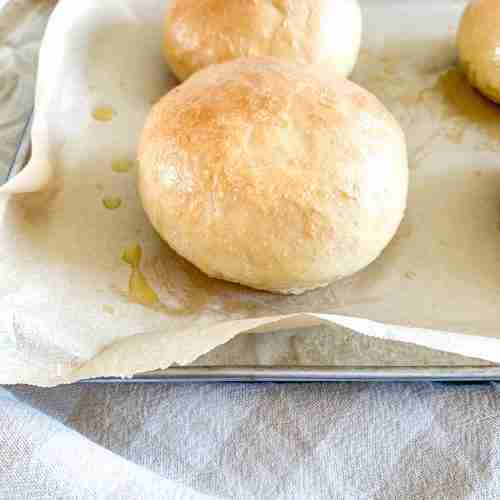
Sourdough Brioche Buns
You know those extra soft buns served at restaurants? Well that's exactly what these sourdough brioche buns are! They've always been my favorite bun so I thought, "why not make them at home?" This recipe is simple and easy, it'll replace any store bought hamburger buns!
Ingredients
- 1/3 cup fed sourdough starter (needs to be active and bubbly)
- 1/3 cup milk (+ 1 Tbsp extra if needed)
- 1 tsp raw honey
- 1 tsp salt
- 2 Tbsp avocado oil (or melted butter)
- 1 3/4 cups all-purpose flour
- 1 egg yolk
- optional – melted butter (for brushing after baking)
Instructions
Preparing your starter
- BEFORE YOU GET STARTED: Feed your entire starter jar 4-12 hours before starting this recipe. I recommend feeding it a 2:1 ratio of unbleached flour to filtered water to get the same results as I do when you make this recipe. Example: 1 cup flour + 1/2 cup water. Your starter needs to be active, bubbly, and a thicker consistency to begin this recipe.
Make the dough
- In a large mixing bowl add in fed starter, milk, honey, salt, and avocado oil. Mix until completely combined.
- Add in only 1 1/2 cups flour (the other 1/4 cup will be added later with the egg) and stir until a dough forms. Use your hands to bring the dough into a ball if needed. If this isn’t working add 1-2 Tablespoons of extra milk to help but don’t do this if not necessary.
- Turn the dough out in the counter and knead for 2-3 minutes (or use an electric mixer with a dough hook)
Bulk ferment
- Cover the dough and let it sit at room temperature on the counter or in a turned-off oven/microwave for 12 hours until it doubles in size. See notes for helpful information.
Add the egg
- Once bulk fermentation is complete your dough should have doubled in size.
- Uncover the dough and add in the egg. This will be sticky but knead it into the dough. THEN add the 1/4 cup of flour and knead that into the dough to help with the stickiness. (Do it this way, egg before flour, to prevent large clumps of eggy flour in your bread)
- Use your hands to knead until it’s completely incorporated. We do this now so we can still enrich the dough but the doesn’t have to bulk ferment with raw egg.
Shape the buns
- Turn the dough out onto the counter and divide into even pieces - 6 (for small buns) or 4 (for larger buns). Add flour to the counter if sticking.
- Shape each piece into a round bun by rolling it on the counter in circular motions to create a ball. Then gently press down on the top to flatten the bottom slightly.
- Do this with each piece to shape them all.
- Place the buns on a parchment lined sheet pan, 2 inches apart.
Proof the dough & bake
- Cover with a dry kitchen towel or seran wrap and let it rise for 3-4 hours at room temperature. (See notes below)
- Once the buns are puffy and have proofed for 3-4 hours, preheat the oven to 375 degrees Fahrenheit.
- Bake for 20-25 minutes or until golden brown and baked all the way through.
- Take out of oven and brush with melted butter. Then let cool on a wire rack. Enjoy!
Video
Notes
What to do if your dough isn't doubling in size during the bulk ferment and/or 2nd rise:
- If your dough doesn't look like it's doing anything halfway through the rises, you need to place it in a slightly warmer area.
- This can be in a turned-off oven with the light on and oven door open, or you can slightly warm the oven to about 75-80 degrees Fahrenheit, then turn it off and place your dough inside with the door shut.
- Never leave the oven on, even on the keep warm setting, with fermenting dough inside. Your dough, for both rises, needs to double.
- If your dough doesn't double even in the warmer area, there is a problem with your starter. It is too weak to ferment the dough even in a warm environment.
- To fix this, you will want to leave your starter out on the counter for 2 days and feed it every 12 hours at a 2:1 ratio of unbleached flour to filtered water.
- For example, 1 cup unbleached flour + 1/2 cup filtered (or bottled) water.
- Make sure you're using unbleached flour and filtered or bottled water to do this. If you don't, it will affect your starter strength. Reverse osmosis water (or any water that uses salt in the filter) can make the starter weak.
- This will strengthen the cultures in your starter to give you fluffy baked bread and treats. After the 2 days, you can go back to feeding it like usual (once a week if stored in the fridge or once a day if stored on the counter). Be sure to use the 2:1 ratio feeding from here on out.